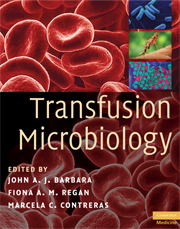Book contents
- Frontmatter
- Contents
- List of contributors
- Foreword
- Preface
- Acknowledgements
- Glossary
- Introduction: Transfusion-transmitted infections, then and now
- Section 1 Agents
- Section 2 Selection and testing
- 10 Blood donor selection and qualification
- 11 Current serological methods of testing and automation
- 12 Confirmatory testing and donor re-admission
- 13 The strategy for applications of nucleic acid testing
- 14 Nucleic acid testing: general view
- 15 Nucleic acid testing: the US approach
- 16 Nucleic acid testing: the UK approach
- 17 Quality in the screening of donations for transfusion-transmissible infections
- 18 Microbiological blood testing and new technologies
- 19 Processing and components: leucodepletion and pathogen reduction
- 20 Fractionated products
- Section 3 Surveillance, risk and regulation
- Index
- Plate section
- References
10 - Blood donor selection and qualification
from Section 2 - Selection and testing
Published online by Cambridge University Press: 12 January 2010
- Frontmatter
- Contents
- List of contributors
- Foreword
- Preface
- Acknowledgements
- Glossary
- Introduction: Transfusion-transmitted infections, then and now
- Section 1 Agents
- Section 2 Selection and testing
- 10 Blood donor selection and qualification
- 11 Current serological methods of testing and automation
- 12 Confirmatory testing and donor re-admission
- 13 The strategy for applications of nucleic acid testing
- 14 Nucleic acid testing: general view
- 15 Nucleic acid testing: the US approach
- 16 Nucleic acid testing: the UK approach
- 17 Quality in the screening of donations for transfusion-transmissible infections
- 18 Microbiological blood testing and new technologies
- 19 Processing and components: leucodepletion and pathogen reduction
- 20 Fractionated products
- Section 3 Surveillance, risk and regulation
- Index
- Plate section
- References
Summary
Introduction: basic principles of blood donor selection
The basic principle of blood donor selection is simply stated: it should be safe for the donor to give blood and the donation should not harm the recipient.
The processes involved in achieving this deceptively simple aim are complex and so interwoven that no attempt can be made to separate out the criteria which might be considered specific for the microbiological safety of the donation.
Increasing public concern and litigation has led to many debates on the meaning of ‘safe’. Calman (2001) draws attention to the importance of clarifying the language of risk; the relationship between safety and perception of safety is debated by many authors in the Millennium Festival of Medicine (2001) (please refer to Chapter 26). A new tool for communicating risk perception is introduced by Lee, et al. (1998). Sadly this excellent and clear method has not yet seen wider acceptance.
The term ‘donor selection’, with its implication that there is an abundance of potential donors from amongst whom the blood services have only to select those who meet their current pre-set criteria, is misleading and outdated. Today, it is the donor who selects the activities he/she participates in and therefore ‘donor qualification’, implying positive action by the donor might be a more appropriate term.
This chapter will examine the problems involved in setting and implementing the selection/qualification criteria, highlight inconsistencies and seek solutions.
- Type
- Chapter
- Information
- Transfusion Microbiology , pp. 153 - 158Publisher: Cambridge University PressPrint publication year: 2008
References
- 1
- Cited by



